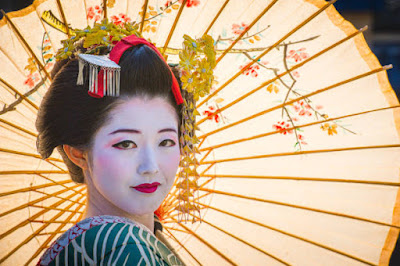Japanese traditional makeup, particularly in historical periods like the Heian, Edo, and Meiji eras, is deeply intertwined with cultural aesthetics, societal status, and traditional performances like kabuki and geisha. Each era and form of makeup had its own distinctive characteristics, tools, and meanings. Here’s a detailed overview of traditional Japanese makeup:
1. Heian Era (794–1185): Aristocratic Beauty
- Aesthetic Ideals: During the Heian period, beauty was strongly associated with pale, smooth skin, and minimal but elegant facial features. Aristocratic women, especially court ladies, followed elaborate beauty rituals.
- Base Makeup: The application of white face powder (oshiroi) was a key aspect. This powder was made from rice flour and ground-up pearls, which gave a luminous pale look, symbolizing purity and nobility.
- Eyebrows and Teeth: Women shaved off their natural eyebrows and painted on higher, arched black eyebrows to symbolize maturity and beauty. Teeth blackening (ohaguro) was a practice where women dyed their teeth with a black lacquer-like substance, a sign of beauty, adulthood, and respectability.
- Lips: Lips were often small and painted with bright red pigment, usually made from safflower petals (beni). The ideal was to emphasize a small, delicate mouth.
2. Edo Period (1603–1868): Geisha and Kabuki Influence
- Geisha Makeup: The traditional makeup of a geisha or apprentice maiko (trainee geisha) is one of the most iconic styles. It’s known for the thick white foundation, red and black accents, and careful attention to detail.
- Base Makeup: A white foundation (oshiroi) is applied to the entire face, neck, and part of the upper back, leaving a "W" or "V" shape at the nape of the neck exposed. This was considered highly sensual and alluring.
- Eyebrows and Eyes: Black and red pigments were used to outline the eyes, making them appear larger and more dramatic. Eyebrows were enhanced with charcoal or black ink for sharp definition.
- Lips: A smaller, pouty lip shape was desired, and lips were painted with red pigment. Only the center of the lips was often colored in, creating a delicate, doll-like effect.
- Kabuki Makeup (Kumadori): Kabuki performers use bold, exaggerated makeup to portray characters. Kumadori makeup involves brightly colored lines painted on the face to emphasize emotions and character types.
- White Base: Similar to the geisha, a white foundation is used to create a blank canvas.
- Bold Colors: Red, blue, and black lines are drawn on the face. Red symbolizes strength and passion, blue represents evil or sadness, and black emphasizes structure and power.
3. Meiji Era (1868–1912): Western Influence and Traditional Blending
- The Meiji era marked a period of modernization and Western influence. While traditional makeup styles persisted, Western cosmetic products and techniques began to enter Japanese society.
- Oshiroi: Still used by traditional performers, the white face powder remained a symbol of beauty, though more women began using Western-style powders and blushes as Japan opened up to foreign trade.
- Eyes and Lips: As Japan modernized, makeup styles began blending traditional Japanese techniques with Western influences. Eye makeup became more subtle, and red lipstick, in a more Western shape, became popular.
4. Geisha Makeup Today
- Modern-day geisha, particularly apprentice maiko, still adhere to traditional makeup practices. Their makeup changes as they progress in their training:
- Maiko Makeup: Young maiko wear the iconic white base with bright red and black accents. Their lips are painted in a smaller shape, often with only the lower lip fully colored. The eyes are highlighted with red and black.
- Older Geisha: Senior geisha use more subtle makeup. The white foundation is lighter, and the lips are painted in a fuller, more mature style. They focus more on elegance and simplicity compared to the elaborate makeup of maiko.
5. Tools and Products
- Oshiroi (White Face Powder): Made from rice powder, it has been a staple of Japanese traditional makeup. Today, modern versions of oshiroi exist in more refined, skin-friendly forms.
- Beni (Red Pigment): Traditionally derived from safflower, beni is used for the lips and sometimes around the eyes.
- Kohl/Charcoal: Used to define the eyebrows and outline the eyes in geisha and kabuki makeup.
- Brushes and Applicators: Makeup was applied with specialized brushes made from natural fibers. Bamboo sticks were also used for precision.
6. Symbolism and Meaning
- White Skin: Pale skin was seen as a symbol of aristocracy and nobility, as it showed that a woman didn’t have to labor outdoors.
- Blackened Teeth (Ohaguro): This was a sign of beauty, maturity, and marital status. It was also considered to protect the teeth from decay.
- Exposed Nape: The nape of the neck, when left exposed through a “V” or “W” shape in the white makeup, was considered highly sensual. The neck is one of the few areas where the skin remains visible in traditional attire, adding to its allure.
7. Contemporary Traditional Makeup in Performances
- Today, traditional makeup can still be seen in kabuki theatre, noh performances, and the makeup of geisha and maiko. The application of this makeup remains a highly skilled art form, requiring years of practice.
- Although modern Japanese makeup tends to follow global trends, traditional styles are preserved in certain cultural settings and festivals.


Comments
Post a Comment